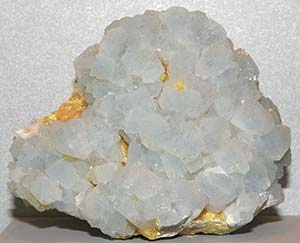 |
| Celestite - SrSO4. |
Strontium is a metallic element that commonly occurs in nature; only two minerals, celestite (SrSO4) and strontianite (SrCO3), however, contain strontium in sufficient quantities to make its recovery practical. Of the two, celestite occurs much more frequently in sedimentary deposits of sufficient size to make mining attractive. Strontianite would be the more useful of the two common minerals because strontium is used most often in the carbonate form. Strontium ores have not mined in the United States since 1959. The world's largest producers are, in descending order of output, Mexico, Spain, and China. The United States imports celestite from Mexico. It is processed into a variety of strontium chemicals that are used mainly in the faceplate glass of color television picture tubes.
Background
Strontium is a silvery-yellow, metallic element. Its atomic number is 38 and its symbol is Sr. It is a relatively soft element.
Strontium was first discovered in 1790 by the Scottish scientist Adair Crawford who was studying samples of a new mineral. This new mineral, strontianite, is now known to be composed of strontium carbonate, SrCO3. Crawford determined that this new mineral contained an element that had never been recognized before, which he identified and called strontium. Pure strontium was not isolated until 1808.
Strontium belongs to a group of elements known as the alkali earth metals. Like other alkali metals, it is chemically active and will react with both air and water.
Two radioactive isotopes of strontium, Strontium-89 and -90, are created by atomic bomb explosions and are found in their radioactive fallout. This radioactive strontium is absorbed by the body and replaces calcium in the bones. Once they become part of the bone, they remain there for the lifetime of the organism, giving off radiation.
There is no biological benefit to strontium.
Name
Named after the village of "Strontian" in Scotland.
Sources
Strontium minerals have not been mined in the United States since 1959. Consequently, U.S. companies import 100% of the strontium minerals needed for strontium. They are imported exclusively from Mexico. In addition, strontium compounds are imported from Mexico (90%) and Germany (9%) and 1% from other nations.
Worldwide resources of strontium minerals have not been completely studied. However, experts estimate that world resources of strontium exceed 1 billion tons.
Uses
Most strontium (76% of the strontium consumed each year) is used to make compounds that are applied to the glass picture tubes on color television sets. This compound blocks the x-rays created by the picture tube.
Some strontium (10%) is used to make special magnets called ferrite ceramic magnets.
Strontium is the element that gives road flares and fireworks a bright red color. Pyrotechnics and flares account for 5% of the annual strontium consumption.
Substitutes and Alternative Sources
There are a few elements that can be used in place of strontium for some of its applications. There are two possible problems with such a substitution. First, no element or compound works as well as strontium in these applications. Second, the possible substitutes can be more expensive than strontium.